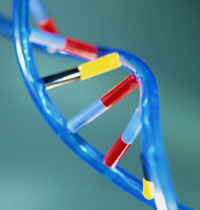Archived Content
The National Institute of Mental Health archives materials that are over 4 years old and no longer being updated. The content on this page is provided for historical reference purposes only and may not reflect current knowledge or information.
Atlas Will Reveal When and Where Genes Turn On in the Brain
ARRA funds Underwrite Collaborative Web “Transcriptome” Resource
• Science Update

When and where in the brain a gene turns on holds clues to its possible role in disease. For example, a recent study found that forms of a gene associated with schizophrenia are over-expressed in the fetal brain, adding to evidence implicating this critical developmental period.
To make such discoveries about what is abnormal, scientists first need to know what the normal patterns of gene expression are during development. To this end, the National Institute of Mental Health (NIMH), part of the National Institutes of Health, is expediting creation of a Transcriptional Atlas of Human Brain Development. The framework of the transcriptional atlas will be completed by the Fall of 2011, with funding under the American Recovery and Reinvestment Act of 2009 (ARRA), but will continue to grow as additional data are collected. This resource will be available via the web as early as the Fall of 2010.
"We know relatively little about how specific risk genes for mental disorders affect brain development or which risk gene variants influence gene expression across development," explained NIMH Director Thomas R. Insel, M.D. "We need to find out which genes are expressed in particular brain regions at specific time points."
To map this human brain "transcriptome," researchers will identify the composition of intermediate products, called transcripts or
messenger RNAs , that translate genes into proteins throughout development. ARRA grants totaling $35 million were awarded in late September to a Consortium of researchers at the University of Southern California (USC), Yale University and the Allen Institute for Brain Science.
Researchers at Yale and USC will read out the genetic letter sequences of transcripts in 16 brain regions at 11 key developmental stages from over 900 samples. The Allen Institute will provide more detailed analysis at the cellular level in a subset of samples. NIMH Intramural Research Program researchers will provide the majority of brain tissue samples.
"We hope to begin to understand how differences in gene expression in distinct brain regions contribute to development of the human brain," explained Michelle Freund, Ph.D., of NIMH's Division of Neuroscience and Basic Behavioral Science, who is coordinating the effort. "We will be able to chart the onset of alternative forms of transcripts and patterns of gene expression in particular brain regions. For example, we'll be able to say 'This particular form of this gene turns on in the hippocampus at 9 weeks.' This continuously updated resource will be invaluable for researchers."
The 11 developmental stages range from 4-7 weeks of embryonic development to mid-adulthood. Fewer brain regions will be assessed at the earliest stages, as some regions cannot be reliably dissected until later in fetal development.
Researchers at the Allen Institute will integrate the Yale and USC findings with high resolution reference images and detailed cellular information into an online multi-modal resource that the research community can query - similar to the Institute's Developing Mouse Brain Atlas and Human Brain Atlas .
"For example, a researcher doing mouse behavioral studies could consult the new human atlas to see where and when a particular gene of interest is expressed in human brain development," said Freund.
A complementary effort by the NIH Blueprint for Neuroscience supports a much smaller scale project that is mapping select gene expression in the developing non-human primate brain using roughly analogous developmental time-points.
Using state of the art high throughput sequencing machines, the researchers hope to complete sequencing of the human transcripts and select regional gene expression patterns by September 2011. Data analysis and development of web based tools to query the data will be ongoing. The USC group will also map environmental, or epigenetic regulation of gene expression across development.
Principal investigators for the transcriptome consortium are:
James Knowles, M.D., Ph.D., Pat Levitt, Ph.D., University of Southern California
Nenad Sestan, Ph.D., Yale University
Ed Lein, Ph.D., Michael Hawrylycz, Ph.D., Allen Institute for Brain Science
Daniel Weinberger, M.D., and Joel Kleinman, M.D., Ph.D., NIMH Genes Cognition and Psychosis Program, will contribute the tissue samples.
